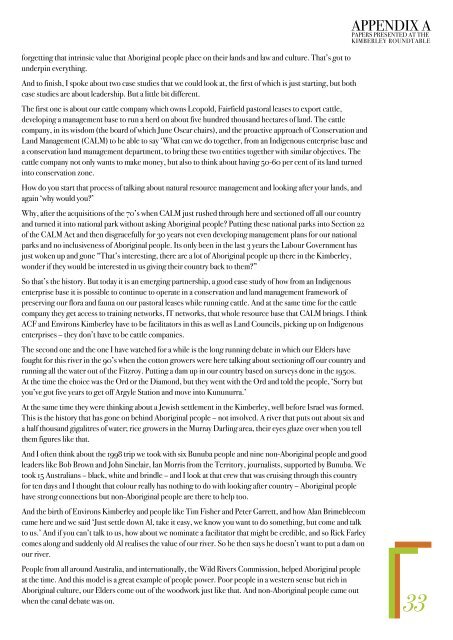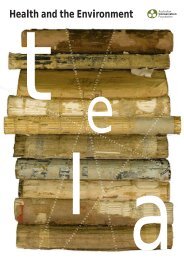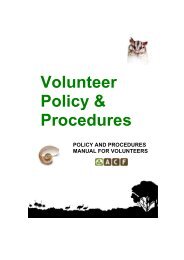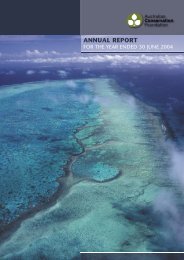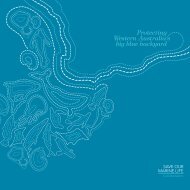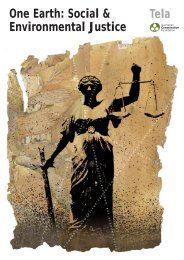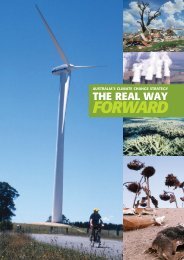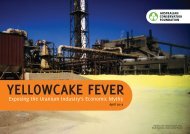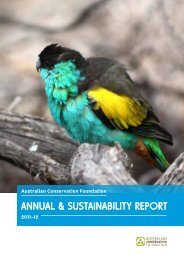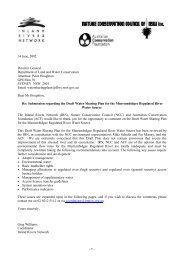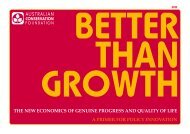Kimberley Appropriate Economics Interim Report - Australian ...
Kimberley Appropriate Economics Interim Report - Australian ...
Kimberley Appropriate Economics Interim Report - Australian ...
Create successful ePaper yourself
Turn your PDF publications into a flip-book with our unique Google optimized e-Paper software.
forgetting that intrinsic value that Aboriginal people place on their lands and law and culture. That’s got to<br />
underpin everything.<br />
And to finish, I spoke about two case studies that we could look at, the first of which is just starting, but both<br />
case studies are about leadership. But a little bit different.<br />
The first one is about our cattle company which owns Leopold, Fairfield pastoral leases to export cattle,<br />
developing a management base to run a herd on about five hundred thousand hectares of land. The cattle<br />
company, in its wisdom (the board of which June Oscar chairs), and the proactive approach of Conservation and<br />
Land Management (CALM) to be able to say ‘What can we do together, from an Indigenous enterprise base and<br />
a conservation land management department, to bring these two entities together with similar objectives. The<br />
cattle company not only wants to make money, but also to think about having 50-60 per cent of its land turned<br />
into conservation zone.<br />
How do you start that process of talking about natural resource management and looking after your lands, and<br />
again ‘why would you?’<br />
Why, after the acquisitions of the 70’s when CALM just rushed through here and sectioned off all our country<br />
and turned it into national park without asking Aboriginal people? Putting these national parks into Section 22<br />
of the CALM Act and then disgracefully for 30 years not even developing management plans for our national<br />
parks and no inclusiveness of Aboriginal people. Its only been in the last 3 years the Labour Government has<br />
just woken up and gone “That’s interesting, there are a lot of Aboriginal people up there in the <strong>Kimberley</strong>,<br />
wonder if they would be interested in us giving their country back to them?”<br />
So that’s the history. But today it is an emerging partnership, a good case study of how from an Indigenous<br />
enterprise base it is possible to continue to operate in a conservation and land management framework of<br />
preserving our flora and fauna on our pastoral leases while running cattle. And at the same time for the cattle<br />
company they get access to training networks, IT networks, that whole resource base that CALM brings. I think<br />
ACF and Environs <strong>Kimberley</strong> have to be facilitators in this as well as Land Councils, picking up on Indigenous<br />
enterprises – they don’t have to be cattle companies.<br />
The second one and the one I have watched for a while is the long running debate in which our Elders have<br />
fought for this river in the 90’s when the cotton growers were here talking about sectioning off our country and<br />
running all the water out of the Fitzroy. Putting a dam up in our country based on surveys done in the 1950s.<br />
At the time the choice was the Ord or the Diamond, but they went with the Ord and told the people, ‘Sorry but<br />
you’ve got five years to get off Argyle Station and move into Kununurra.’<br />
At the same time they were thinking about a Jewish settlement in the <strong>Kimberley</strong>, well before Israel was formed.<br />
This is the history that has gone on behind Aboriginal people – not involved. A river that puts out about six and<br />
a half thousand gigalitres of water; rice growers in the Murray Darling area, their eyes glaze over when you tell<br />
them figures like that.<br />
And I often think about the 1998 trip we took with six Bunuba people and nine non-Aboriginal people and good<br />
leaders like Bob Brown and John Sinclair, Ian Morris from the Territory, journalists, supported by Bunuba. We<br />
took 15 <strong>Australian</strong>s – black, white and brindle – and I look at that crew that was cruising through this country<br />
for ten days and I thought that colour really has nothing to do with looking after country – Aboriginal people<br />
have strong connections but non-Aboriginal people are there to help too.<br />
And the birth of Environs <strong>Kimberley</strong> and people like Tim Fisher and Peter Garrett, and how Alan Brimeblecom<br />
came here and we said ‘Just settle down Al, take it easy, we know you want to do something, but come and talk<br />
to us.’ And if you can’t talk to us, how about we nominate a facilitator that might be credible, and so Rick Farley<br />
comes along and suddenly old Al realises the value of our river. So he then says he doesn’t want to put a dam on<br />
our river.<br />
People from all around Australia, and internationally, the Wild Rivers Commission, helped Aboriginal people<br />
at the time. And this model is a great example of people power. Poor people in a western sense but rich in<br />
Aboriginal culture, our Elders come out of the woodwork just like that. And non-Aboriginal people came out<br />
when the canal debate was on.<br />
33


